Business Organisation and Structure Report: Sectors and Functions
VerifiedAdded on 2020/10/23
|8
|2083
|487
Report
AI Summary
This report delves into the core concepts of business organization and structure, providing a comprehensive overview of various business sectors, including private, public, and voluntary entities. It examines the purpose and activities of key business functions such as finance, human resources, marketing, production/operations, and research and development, highlighting their significance in achieving organizational goals. Furthermore, the report analyzes different organizational structures, including matrix, divisional, functional, flat, and hierarchical structures, with a focus on how companies like Marks and Spencer and Tesco employ these structures. The report concludes by summarizing the key findings, emphasizing the importance of organizational structure in attaining business objectives and maintaining a competitive edge in the global market. The report also includes references to relevant books and journals that support the findings.
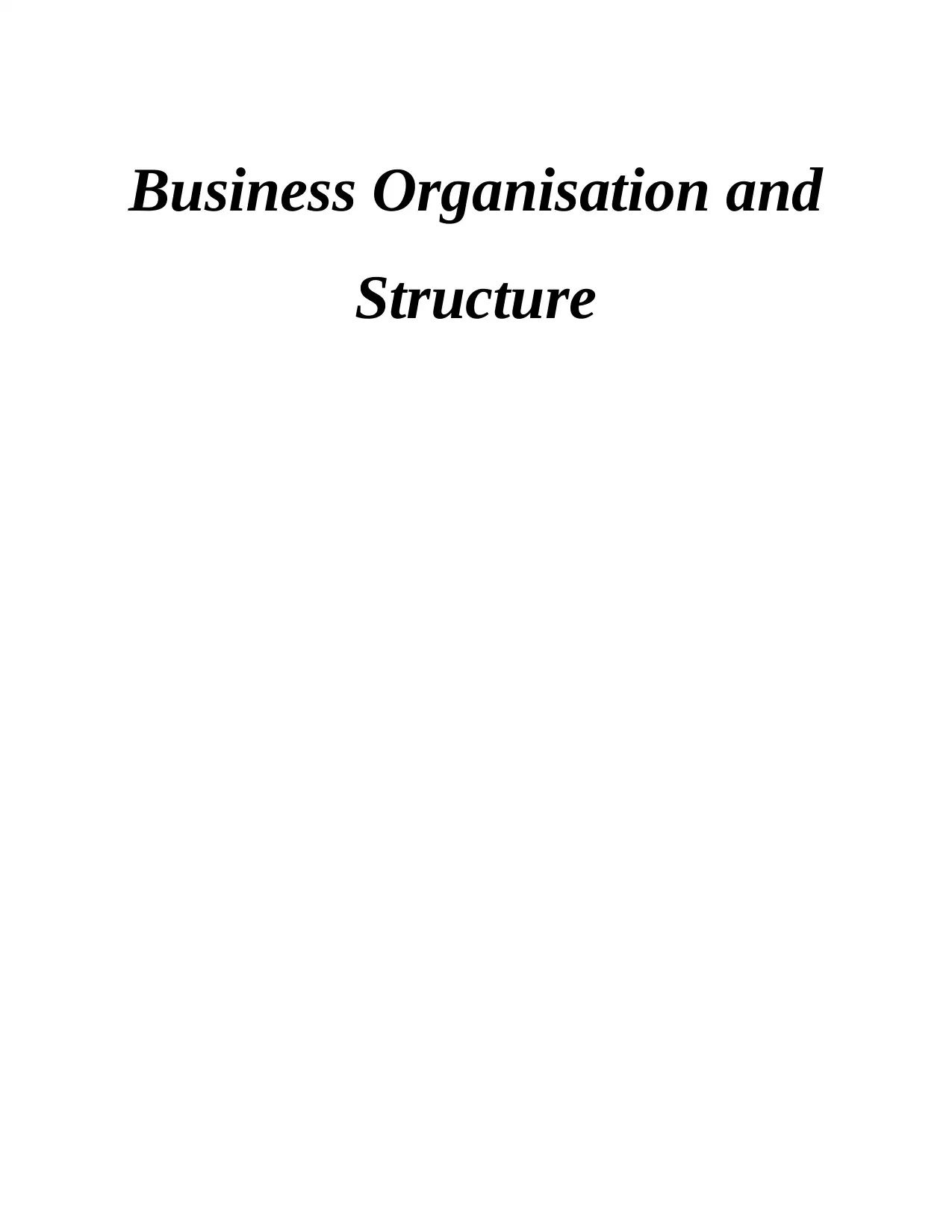
Business Organisation and
Structure
Structure
Paraphrase This Document
Need a fresh take? Get an instant paraphrase of this document with our AI Paraphraser
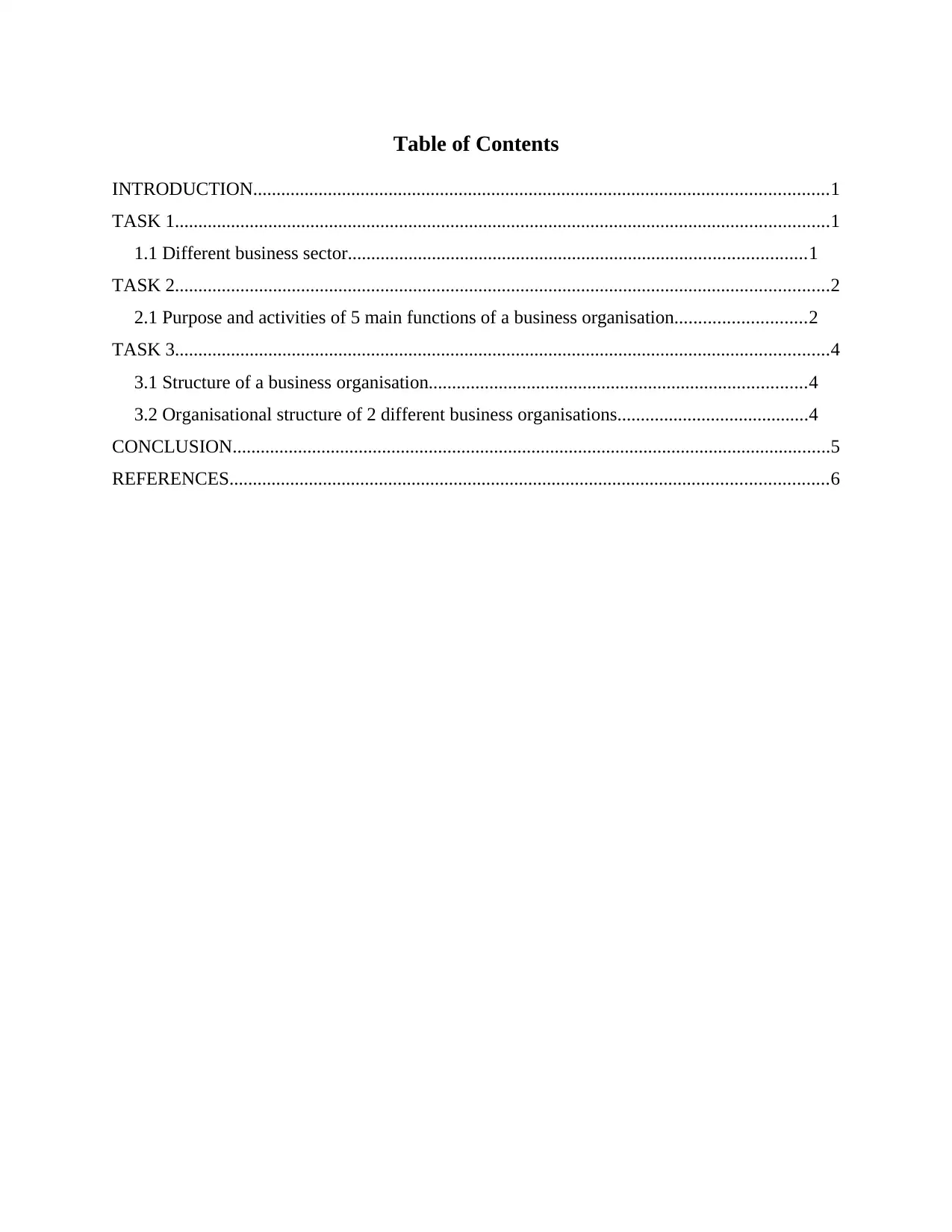
Table of Contents
INTRODUCTION...........................................................................................................................1
TASK 1............................................................................................................................................1
1.1 Different business sector..................................................................................................1
TASK 2............................................................................................................................................2
2.1 Purpose and activities of 5 main functions of a business organisation............................2
TASK 3............................................................................................................................................4
3.1 Structure of a business organisation.................................................................................4
3.2 Organisational structure of 2 different business organisations.........................................4
CONCLUSION................................................................................................................................5
REFERENCES................................................................................................................................6
INTRODUCTION...........................................................................................................................1
TASK 1............................................................................................................................................1
1.1 Different business sector..................................................................................................1
TASK 2............................................................................................................................................2
2.1 Purpose and activities of 5 main functions of a business organisation............................2
TASK 3............................................................................................................................................4
3.1 Structure of a business organisation.................................................................................4
3.2 Organisational structure of 2 different business organisations.........................................4
CONCLUSION................................................................................................................................5
REFERENCES................................................................................................................................6
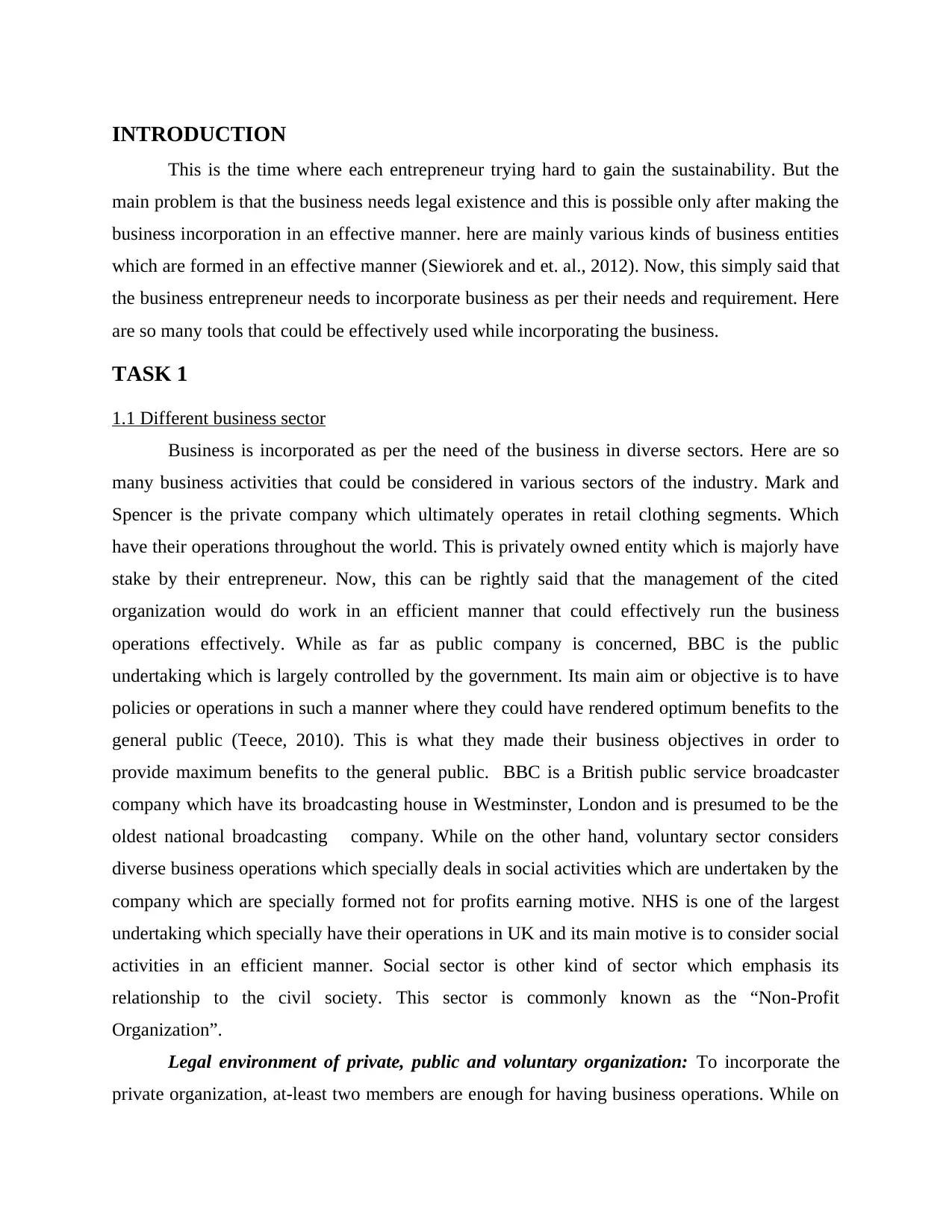
INTRODUCTION
This is the time where each entrepreneur trying hard to gain the sustainability. But the
main problem is that the business needs legal existence and this is possible only after making the
business incorporation in an effective manner. here are mainly various kinds of business entities
which are formed in an effective manner (Siewiorek and et. al., 2012). Now, this simply said that
the business entrepreneur needs to incorporate business as per their needs and requirement. Here
are so many tools that could be effectively used while incorporating the business.
TASK 1
1.1 Different business sector
Business is incorporated as per the need of the business in diverse sectors. Here are so
many business activities that could be considered in various sectors of the industry. Mark and
Spencer is the private company which ultimately operates in retail clothing segments. Which
have their operations throughout the world. This is privately owned entity which is majorly have
stake by their entrepreneur. Now, this can be rightly said that the management of the cited
organization would do work in an efficient manner that could effectively run the business
operations effectively. While as far as public company is concerned, BBC is the public
undertaking which is largely controlled by the government. Its main aim or objective is to have
policies or operations in such a manner where they could have rendered optimum benefits to the
general public (Teece, 2010). This is what they made their business objectives in order to
provide maximum benefits to the general public. BBC is a British public service broadcaster
company which have its broadcasting house in Westminster, London and is presumed to be the
oldest national broadcasting company. While on the other hand, voluntary sector considers
diverse business operations which specially deals in social activities which are undertaken by the
company which are specially formed not for profits earning motive. NHS is one of the largest
undertaking which specially have their operations in UK and its main motive is to consider social
activities in an efficient manner. Social sector is other kind of sector which emphasis its
relationship to the civil society. This sector is commonly known as the “Non-Profit
Organization”.
Legal environment of private, public and voluntary organization: To incorporate the
private organization, at-least two members are enough for having business operations. While on
This is the time where each entrepreneur trying hard to gain the sustainability. But the
main problem is that the business needs legal existence and this is possible only after making the
business incorporation in an effective manner. here are mainly various kinds of business entities
which are formed in an effective manner (Siewiorek and et. al., 2012). Now, this simply said that
the business entrepreneur needs to incorporate business as per their needs and requirement. Here
are so many tools that could be effectively used while incorporating the business.
TASK 1
1.1 Different business sector
Business is incorporated as per the need of the business in diverse sectors. Here are so
many business activities that could be considered in various sectors of the industry. Mark and
Spencer is the private company which ultimately operates in retail clothing segments. Which
have their operations throughout the world. This is privately owned entity which is majorly have
stake by their entrepreneur. Now, this can be rightly said that the management of the cited
organization would do work in an efficient manner that could effectively run the business
operations effectively. While as far as public company is concerned, BBC is the public
undertaking which is largely controlled by the government. Its main aim or objective is to have
policies or operations in such a manner where they could have rendered optimum benefits to the
general public (Teece, 2010). This is what they made their business objectives in order to
provide maximum benefits to the general public. BBC is a British public service broadcaster
company which have its broadcasting house in Westminster, London and is presumed to be the
oldest national broadcasting company. While on the other hand, voluntary sector considers
diverse business operations which specially deals in social activities which are undertaken by the
company which are specially formed not for profits earning motive. NHS is one of the largest
undertaking which specially have their operations in UK and its main motive is to consider social
activities in an efficient manner. Social sector is other kind of sector which emphasis its
relationship to the civil society. This sector is commonly known as the “Non-Profit
Organization”.
Legal environment of private, public and voluntary organization: To incorporate the
private organization, at-least two members are enough for having business operations. While on
You're viewing a preview
Unlock full access by subscribing today!
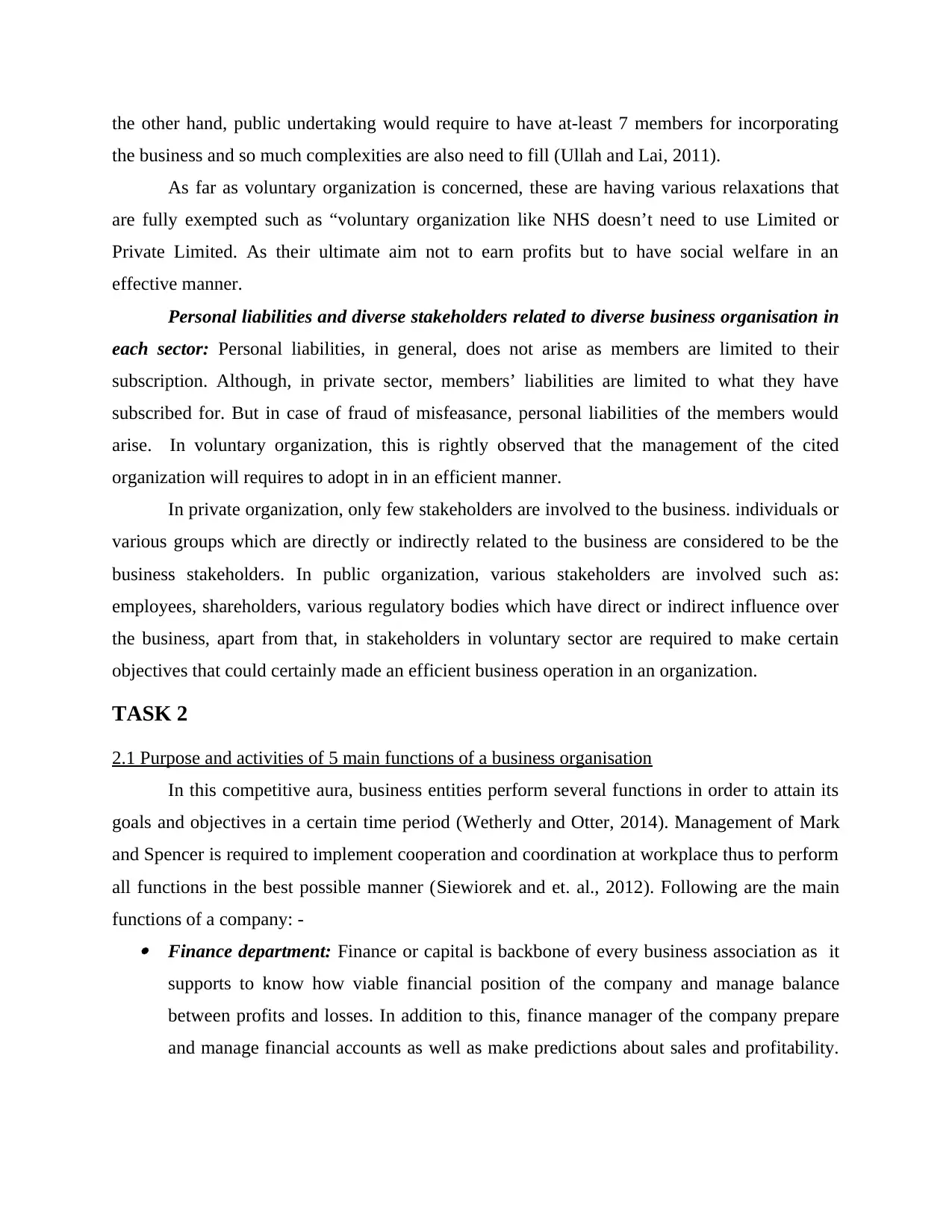
the other hand, public undertaking would require to have at-least 7 members for incorporating
the business and so much complexities are also need to fill (Ullah and Lai, 2011).
As far as voluntary organization is concerned, these are having various relaxations that
are fully exempted such as “voluntary organization like NHS doesn’t need to use Limited or
Private Limited. As their ultimate aim not to earn profits but to have social welfare in an
effective manner.
Personal liabilities and diverse stakeholders related to diverse business organisation in
each sector: Personal liabilities, in general, does not arise as members are limited to their
subscription. Although, in private sector, members’ liabilities are limited to what they have
subscribed for. But in case of fraud of misfeasance, personal liabilities of the members would
arise. In voluntary organization, this is rightly observed that the management of the cited
organization will requires to adopt in in an efficient manner.
In private organization, only few stakeholders are involved to the business. individuals or
various groups which are directly or indirectly related to the business are considered to be the
business stakeholders. In public organization, various stakeholders are involved such as:
employees, shareholders, various regulatory bodies which have direct or indirect influence over
the business, apart from that, in stakeholders in voluntary sector are required to make certain
objectives that could certainly made an efficient business operation in an organization.
TASK 2
2.1 Purpose and activities of 5 main functions of a business organisation
In this competitive aura, business entities perform several functions in order to attain its
goals and objectives in a certain time period (Wetherly and Otter, 2014). Management of Mark
and Spencer is required to implement cooperation and coordination at workplace thus to perform
all functions in the best possible manner (Siewiorek and et. al., 2012). Following are the main
functions of a company: - Finance department: Finance or capital is backbone of every business association as it
supports to know how viable financial position of the company and manage balance
between profits and losses. In addition to this, finance manager of the company prepare
and manage financial accounts as well as make predictions about sales and profitability.
the business and so much complexities are also need to fill (Ullah and Lai, 2011).
As far as voluntary organization is concerned, these are having various relaxations that
are fully exempted such as “voluntary organization like NHS doesn’t need to use Limited or
Private Limited. As their ultimate aim not to earn profits but to have social welfare in an
effective manner.
Personal liabilities and diverse stakeholders related to diverse business organisation in
each sector: Personal liabilities, in general, does not arise as members are limited to their
subscription. Although, in private sector, members’ liabilities are limited to what they have
subscribed for. But in case of fraud of misfeasance, personal liabilities of the members would
arise. In voluntary organization, this is rightly observed that the management of the cited
organization will requires to adopt in in an efficient manner.
In private organization, only few stakeholders are involved to the business. individuals or
various groups which are directly or indirectly related to the business are considered to be the
business stakeholders. In public organization, various stakeholders are involved such as:
employees, shareholders, various regulatory bodies which have direct or indirect influence over
the business, apart from that, in stakeholders in voluntary sector are required to make certain
objectives that could certainly made an efficient business operation in an organization.
TASK 2
2.1 Purpose and activities of 5 main functions of a business organisation
In this competitive aura, business entities perform several functions in order to attain its
goals and objectives in a certain time period (Wetherly and Otter, 2014). Management of Mark
and Spencer is required to implement cooperation and coordination at workplace thus to perform
all functions in the best possible manner (Siewiorek and et. al., 2012). Following are the main
functions of a company: - Finance department: Finance or capital is backbone of every business association as it
supports to know how viable financial position of the company and manage balance
between profits and losses. In addition to this, finance manager of the company prepare
and manage financial accounts as well as make predictions about sales and profitability.
Paraphrase This Document
Need a fresh take? Get an instant paraphrase of this document with our AI Paraphraser
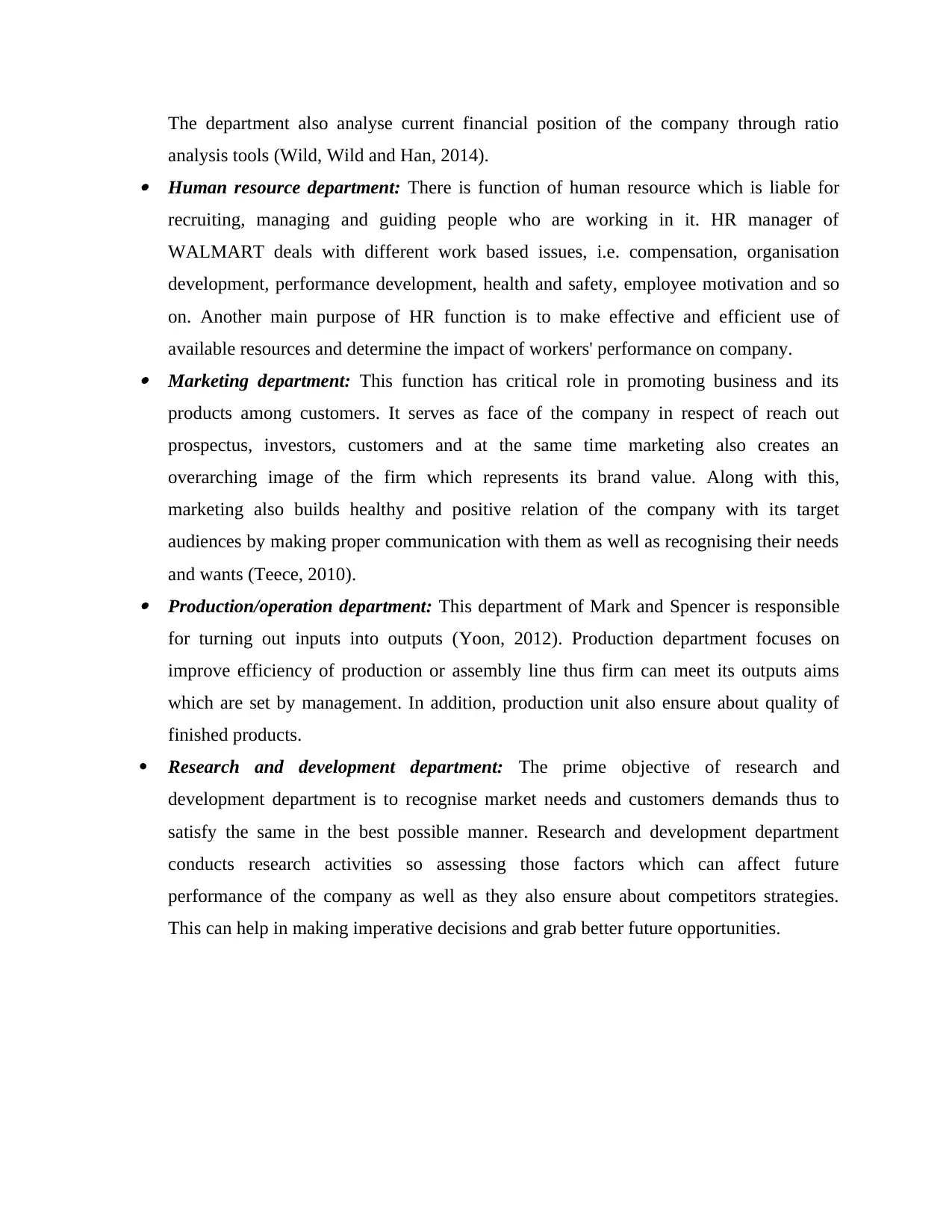
The department also analyse current financial position of the company through ratio
analysis tools (Wild, Wild and Han, 2014). Human resource department: There is function of human resource which is liable for
recruiting, managing and guiding people who are working in it. HR manager of
WALMART deals with different work based issues, i.e. compensation, organisation
development, performance development, health and safety, employee motivation and so
on. Another main purpose of HR function is to make effective and efficient use of
available resources and determine the impact of workers' performance on company. Marketing department: This function has critical role in promoting business and its
products among customers. It serves as face of the company in respect of reach out
prospectus, investors, customers and at the same time marketing also creates an
overarching image of the firm which represents its brand value. Along with this,
marketing also builds healthy and positive relation of the company with its target
audiences by making proper communication with them as well as recognising their needs
and wants (Teece, 2010). Production/operation department: This department of Mark and Spencer is responsible
for turning out inputs into outputs (Yoon, 2012). Production department focuses on
improve efficiency of production or assembly line thus firm can meet its outputs aims
which are set by management. In addition, production unit also ensure about quality of
finished products.
Research and development department: The prime objective of research and
development department is to recognise market needs and customers demands thus to
satisfy the same in the best possible manner. Research and development department
conducts research activities so assessing those factors which can affect future
performance of the company as well as they also ensure about competitors strategies.
This can help in making imperative decisions and grab better future opportunities.
analysis tools (Wild, Wild and Han, 2014). Human resource department: There is function of human resource which is liable for
recruiting, managing and guiding people who are working in it. HR manager of
WALMART deals with different work based issues, i.e. compensation, organisation
development, performance development, health and safety, employee motivation and so
on. Another main purpose of HR function is to make effective and efficient use of
available resources and determine the impact of workers' performance on company. Marketing department: This function has critical role in promoting business and its
products among customers. It serves as face of the company in respect of reach out
prospectus, investors, customers and at the same time marketing also creates an
overarching image of the firm which represents its brand value. Along with this,
marketing also builds healthy and positive relation of the company with its target
audiences by making proper communication with them as well as recognising their needs
and wants (Teece, 2010). Production/operation department: This department of Mark and Spencer is responsible
for turning out inputs into outputs (Yoon, 2012). Production department focuses on
improve efficiency of production or assembly line thus firm can meet its outputs aims
which are set by management. In addition, production unit also ensure about quality of
finished products.
Research and development department: The prime objective of research and
development department is to recognise market needs and customers demands thus to
satisfy the same in the best possible manner. Research and development department
conducts research activities so assessing those factors which can affect future
performance of the company as well as they also ensure about competitors strategies.
This can help in making imperative decisions and grab better future opportunities.
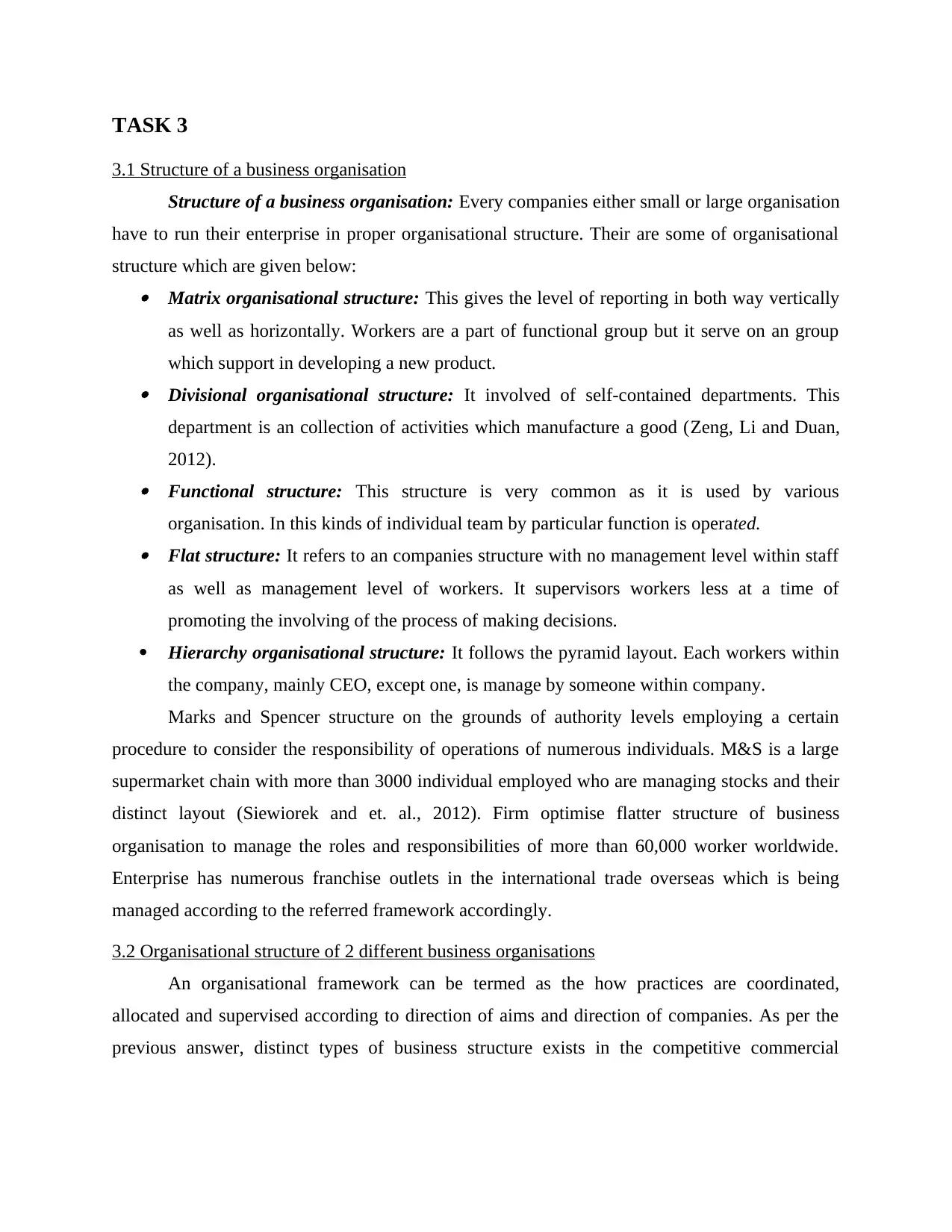
TASK 3
3.1 Structure of a business organisation
Structure of a business organisation: Every companies either small or large organisation
have to run their enterprise in proper organisational structure. Their are some of organisational
structure which are given below: Matrix organisational structure: This gives the level of reporting in both way vertically
as well as horizontally. Workers are a part of functional group but it serve on an group
which support in developing a new product. Divisional organisational structure: It involved of self-contained departments. This
department is an collection of activities which manufacture a good (Zeng, Li and Duan,
2012). Functional structure: This structure is very common as it is used by various
organisation. In this kinds of individual team by particular function is operated. Flat structure: It refers to an companies structure with no management level within staff
as well as management level of workers. It supervisors workers less at a time of
promoting the involving of the process of making decisions.
Hierarchy organisational structure: It follows the pyramid layout. Each workers within
the company, mainly CEO, except one, is manage by someone within company.
Marks and Spencer structure on the grounds of authority levels employing a certain
procedure to consider the responsibility of operations of numerous individuals. M&S is a large
supermarket chain with more than 3000 individual employed who are managing stocks and their
distinct layout (Siewiorek and et. al., 2012). Firm optimise flatter structure of business
organisation to manage the roles and responsibilities of more than 60,000 worker worldwide.
Enterprise has numerous franchise outlets in the international trade overseas which is being
managed according to the referred framework accordingly.
3.2 Organisational structure of 2 different business organisations
An organisational framework can be termed as the how practices are coordinated,
allocated and supervised according to direction of aims and direction of companies. As per the
previous answer, distinct types of business structure exists in the competitive commercial
3.1 Structure of a business organisation
Structure of a business organisation: Every companies either small or large organisation
have to run their enterprise in proper organisational structure. Their are some of organisational
structure which are given below: Matrix organisational structure: This gives the level of reporting in both way vertically
as well as horizontally. Workers are a part of functional group but it serve on an group
which support in developing a new product. Divisional organisational structure: It involved of self-contained departments. This
department is an collection of activities which manufacture a good (Zeng, Li and Duan,
2012). Functional structure: This structure is very common as it is used by various
organisation. In this kinds of individual team by particular function is operated. Flat structure: It refers to an companies structure with no management level within staff
as well as management level of workers. It supervisors workers less at a time of
promoting the involving of the process of making decisions.
Hierarchy organisational structure: It follows the pyramid layout. Each workers within
the company, mainly CEO, except one, is manage by someone within company.
Marks and Spencer structure on the grounds of authority levels employing a certain
procedure to consider the responsibility of operations of numerous individuals. M&S is a large
supermarket chain with more than 3000 individual employed who are managing stocks and their
distinct layout (Siewiorek and et. al., 2012). Firm optimise flatter structure of business
organisation to manage the roles and responsibilities of more than 60,000 worker worldwide.
Enterprise has numerous franchise outlets in the international trade overseas which is being
managed according to the referred framework accordingly.
3.2 Organisational structure of 2 different business organisations
An organisational framework can be termed as the how practices are coordinated,
allocated and supervised according to direction of aims and direction of companies. As per the
previous answer, distinct types of business structure exists in the competitive commercial
You're viewing a preview
Unlock full access by subscribing today!
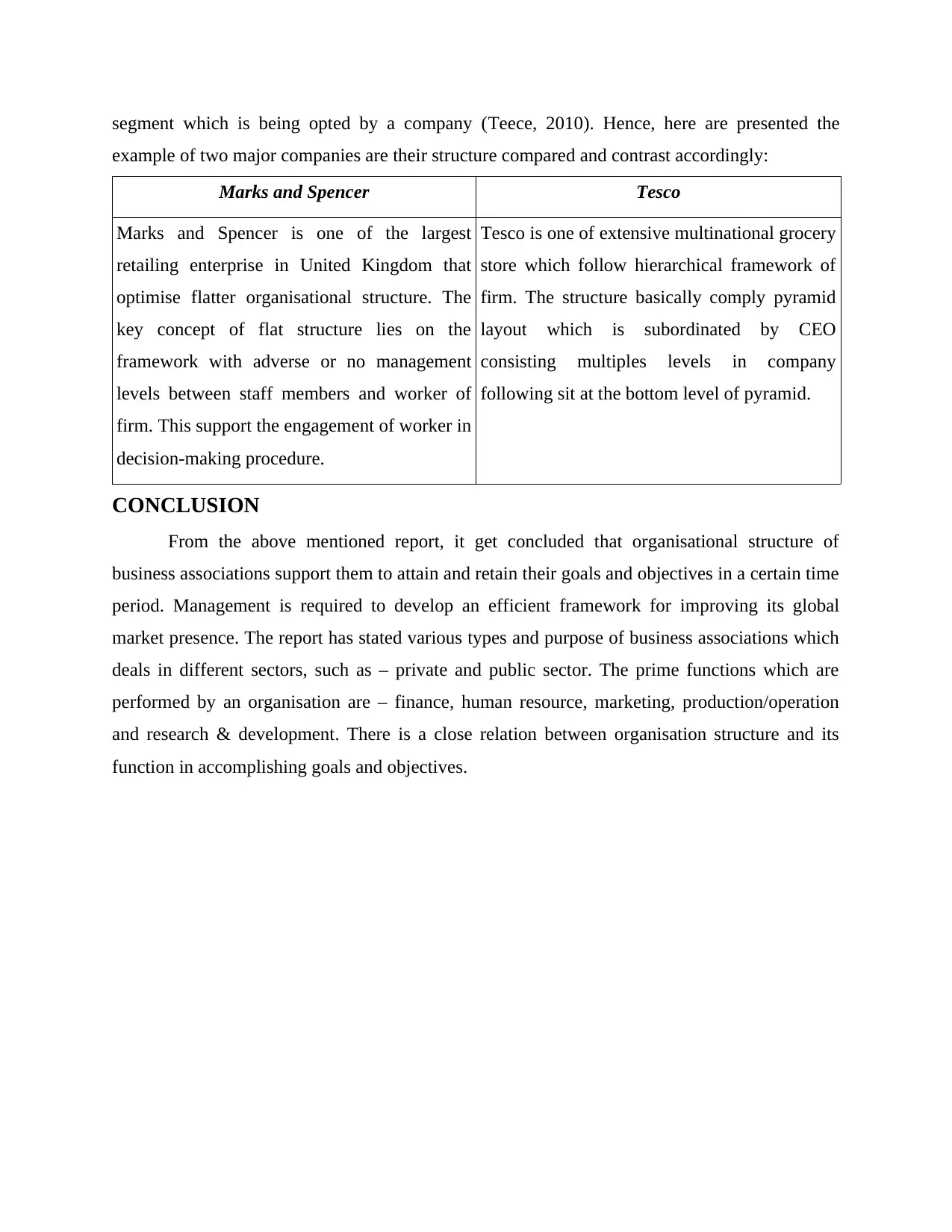
segment which is being opted by a company (Teece, 2010). Hence, here are presented the
example of two major companies are their structure compared and contrast accordingly:
Marks and Spencer Tesco
Marks and Spencer is one of the largest
retailing enterprise in United Kingdom that
optimise flatter organisational structure. The
key concept of flat structure lies on the
framework with adverse or no management
levels between staff members and worker of
firm. This support the engagement of worker in
decision-making procedure.
Tesco is one of extensive multinational grocery
store which follow hierarchical framework of
firm. The structure basically comply pyramid
layout which is subordinated by CEO
consisting multiples levels in company
following sit at the bottom level of pyramid.
CONCLUSION
From the above mentioned report, it get concluded that organisational structure of
business associations support them to attain and retain their goals and objectives in a certain time
period. Management is required to develop an efficient framework for improving its global
market presence. The report has stated various types and purpose of business associations which
deals in different sectors, such as – private and public sector. The prime functions which are
performed by an organisation are – finance, human resource, marketing, production/operation
and research & development. There is a close relation between organisation structure and its
function in accomplishing goals and objectives.
example of two major companies are their structure compared and contrast accordingly:
Marks and Spencer Tesco
Marks and Spencer is one of the largest
retailing enterprise in United Kingdom that
optimise flatter organisational structure. The
key concept of flat structure lies on the
framework with adverse or no management
levels between staff members and worker of
firm. This support the engagement of worker in
decision-making procedure.
Tesco is one of extensive multinational grocery
store which follow hierarchical framework of
firm. The structure basically comply pyramid
layout which is subordinated by CEO
consisting multiples levels in company
following sit at the bottom level of pyramid.
CONCLUSION
From the above mentioned report, it get concluded that organisational structure of
business associations support them to attain and retain their goals and objectives in a certain time
period. Management is required to develop an efficient framework for improving its global
market presence. The report has stated various types and purpose of business associations which
deals in different sectors, such as – private and public sector. The prime functions which are
performed by an organisation are – finance, human resource, marketing, production/operation
and research & development. There is a close relation between organisation structure and its
function in accomplishing goals and objectives.
Paraphrase This Document
Need a fresh take? Get an instant paraphrase of this document with our AI Paraphraser
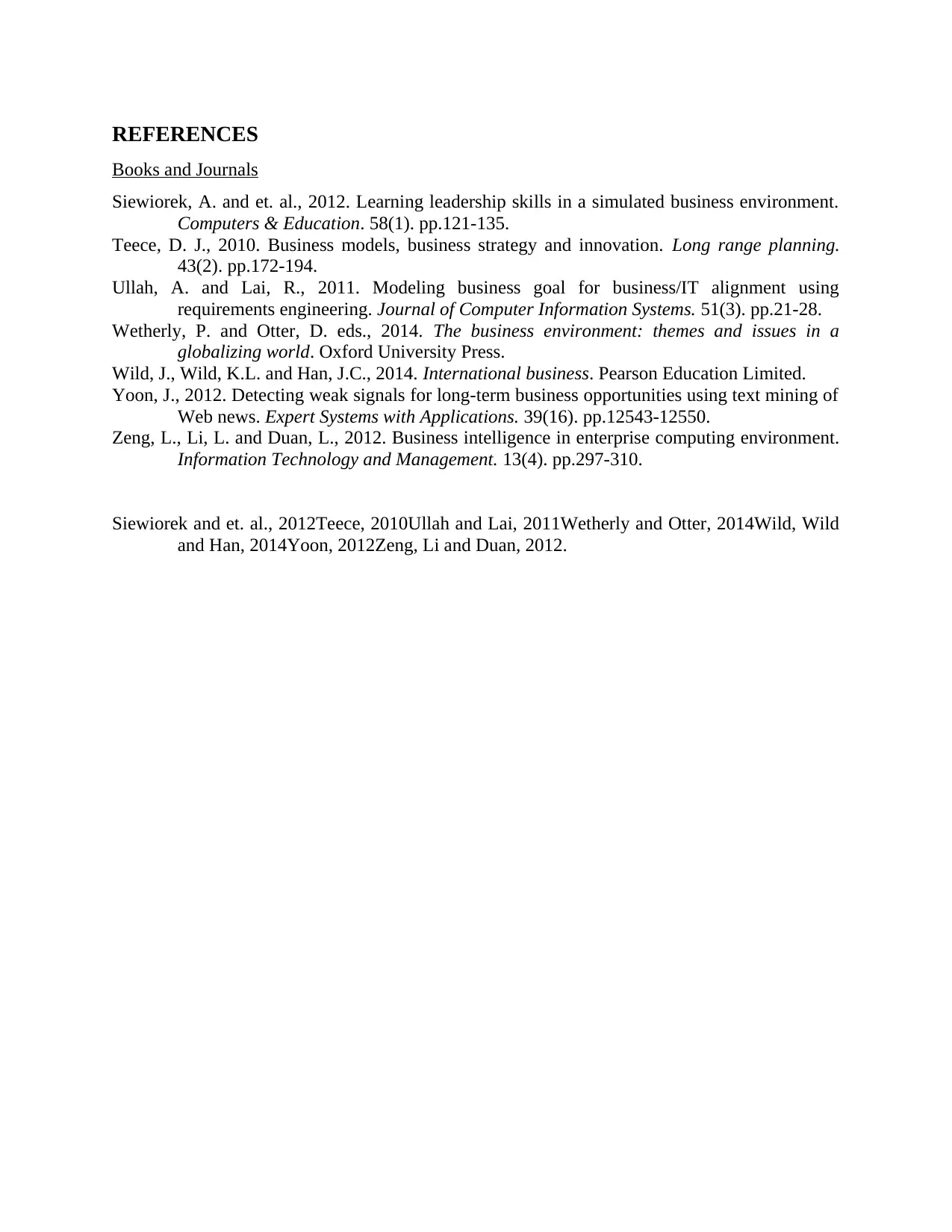
REFERENCES
Books and Journals
Siewiorek, A. and et. al., 2012. Learning leadership skills in a simulated business environment.
Computers & Education. 58(1). pp.121-135.
Teece, D. J., 2010. Business models, business strategy and innovation. Long range planning.
43(2). pp.172-194.
Ullah, A. and Lai, R., 2011. Modeling business goal for business/IT alignment using
requirements engineering. Journal of Computer Information Systems. 51(3). pp.21-28.
Wetherly, P. and Otter, D. eds., 2014. The business environment: themes and issues in a
globalizing world. Oxford University Press.
Wild, J., Wild, K.L. and Han, J.C., 2014. International business. Pearson Education Limited.
Yoon, J., 2012. Detecting weak signals for long-term business opportunities using text mining of
Web news. Expert Systems with Applications. 39(16). pp.12543-12550.
Zeng, L., Li, L. and Duan, L., 2012. Business intelligence in enterprise computing environment.
Information Technology and Management. 13(4). pp.297-310.
Siewiorek and et. al., 2012Teece, 2010Ullah and Lai, 2011Wetherly and Otter, 2014Wild, Wild
and Han, 2014Yoon, 2012Zeng, Li and Duan, 2012.
Books and Journals
Siewiorek, A. and et. al., 2012. Learning leadership skills in a simulated business environment.
Computers & Education. 58(1). pp.121-135.
Teece, D. J., 2010. Business models, business strategy and innovation. Long range planning.
43(2). pp.172-194.
Ullah, A. and Lai, R., 2011. Modeling business goal for business/IT alignment using
requirements engineering. Journal of Computer Information Systems. 51(3). pp.21-28.
Wetherly, P. and Otter, D. eds., 2014. The business environment: themes and issues in a
globalizing world. Oxford University Press.
Wild, J., Wild, K.L. and Han, J.C., 2014. International business. Pearson Education Limited.
Yoon, J., 2012. Detecting weak signals for long-term business opportunities using text mining of
Web news. Expert Systems with Applications. 39(16). pp.12543-12550.
Zeng, L., Li, L. and Duan, L., 2012. Business intelligence in enterprise computing environment.
Information Technology and Management. 13(4). pp.297-310.
Siewiorek and et. al., 2012Teece, 2010Ullah and Lai, 2011Wetherly and Otter, 2014Wild, Wild
and Han, 2014Yoon, 2012Zeng, Li and Duan, 2012.
1 out of 8
Related Documents
Your All-in-One AI-Powered Toolkit for Academic Success.
+13062052269
info@desklib.com
Available 24*7 on WhatsApp / Email
![[object Object]](/_next/static/media/star-bottom.7253800d.svg)
Unlock your academic potential
© 2024 | Zucol Services PVT LTD | All rights reserved.




![Business and Business Environment Analysis Report - [Course Name]](/_next/image/?url=https%3A%2F%2Fdesklib.com%2Fmedia%2Fimages%2Fsh%2F1f2b172c364e48c8beb7aaca2d402a17.jpg&w=256&q=75)
